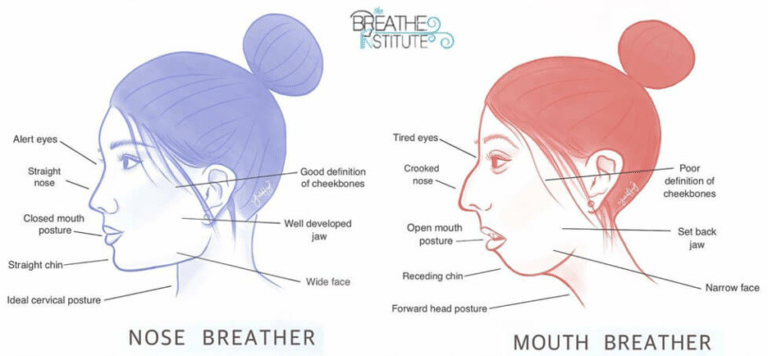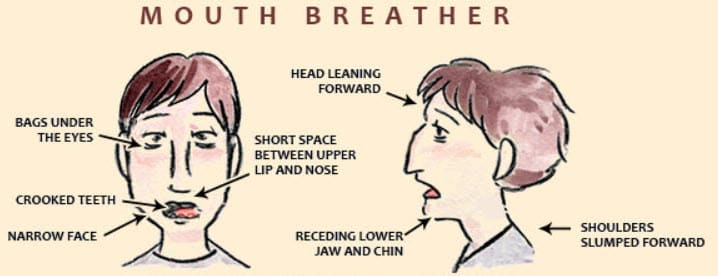Health Info » Dental and Whole Body Health » Your Appearance—Genetics vs. Breathing
Your Appearance—Genetics vs. Breathing
Table of Contents

My Experience
I’ve always thought my appearance was dictated by genetics.
However, recently I have learned that something super simple and common may affect it much more: breathing.
I have a fairly prominent ridge near the top of my nose. Some might even call it big.
In fact, last time I bought a new pair of glasses for work, I had to have them specially made to sit low enough on my face so I could see through the lenses as opposed to peering out underneath them.
I can hardly find a pair of sunglasses that cover my eyes instead of my forehead.
I always joke that if I ever had plastic surgery, it wouldn’t be to alter my appearance, it would be strictly so I could wear normal sunglasses.
Are genetics 100% to blame?
All joking aside, I haven’t thought too much about my nose until recently.
And it’s not because of the way it looks. It’s not even because of my glasses.
It’s because of this picture:

Photo courtesy of The Breathe Institute
Wow! What in the world is going on here?
Is this possible?
Can your breathing change your appearance?
What about genetics? Isn’t the way I look based entirely on my DNA?
I always thought the blame for my struggle with sunglasses could be placed on some of my prominent-nosed ancestors from Denmark.
Does my genetic make-up play a role? Absolutely—a huge role in fact.
But new research suggests that my ancestors aren’t entirely to blame.
So, what exactly is going on here?
Form Follows Function
Anyone who has every taken a biology or anatomy class has probably heard this phrase: “Form follows function.”
You’ve seen this if you lifted weights and bulked up.
You’ve seen it in babies who sleep in the same position all the time and develop a flat spot on their heads.
And you’ve certainly seen it in wrinkles that develop in the skin as facial expressions are repeated again and again for years.
Our bodies have an incredible capacity for adaptation.
This is especially true with muscles that pull on bone. Bone is living tissue and will adapt to the strong forces pulling or pushing on it by the muscles.
In some cases, the bone becomes denser, in other cases it actually grows longer or changes shape. Few people realize, however, that those adaptations can actually alter the way we look and feel.
Our Tongue—Friend or Foe?

Let’s look at our example of nose breathers vs. mouth breathers.
Why do they look so different, even when the genetic makeup is theoretically the same?
The answer lies in the tongue. An extremely powerful muscle, the tongue can be our best friend or worst enemy.
Why?
The body is suited for breathing mostly through the nose. Air can be warmed, moistened, and filtered as it passes through the nose.
In this case, the tongue rests against the roof of the mouth and puts pressure on the inside of the upper teeth and the palate. As children grow and develop, this acts as a natural expander to widen the upper jaw and counteract the pressure of the cheek muscles pushing inward.
In mouth breathers, however, the mouth is open, and the tongue is forced down and forward to allow air to pass through the mouth and into the throat. The cold, dry, dirty air rushes over the teeth and gums and into the back of the throat.
The tissue of the mouth, tonsils, and throat dries out and becomes inflamed. The tonsils often enlarge, compounding the issue.
The tongue is no longer putting needed pressure on the teeth and roof of the mouth, the cheeks continue to push inward, and the upper jaw becomes narrow.
This often results in a long, narrow face, receded chin, gummy smile, crooked or crowded teeth, and an enlarged nose.
There it is—the likely culprit of my prominent nose!
What causes mouth breathing?

So, if mouth breathing is so damaging, what causes it in the first place?
And can it be corrected?
There are a number of reasons that a child may develop a mouth breathing habit:
- Tongue tie
- Deviated septum
- Severe environmental allergies
- Dietary allergies
- Prolonged pacifier use
- Bottle feeding
- Poor tongue strength
- Oral habits
Whatever the reason, there are a few things you can look for in a child to identify a mouth breathing habit:
- Mouth open when sleeping
- Snoring – children should not snore
- Mouth open when relaxing or watching TV
- Noisy breathing – breathing should be silent
- Frequent colds, ear infections, or upper respiratory infections
- Enlarged tonsils
- Dark circles under the eyes
You may also notice some behavioral signs in children who are not sleeping well due to trouble breathing properly at night.
These include poor attention span, irritability, bed wetting, frequent tiredness, and poor memory.
The Solution
So, what can be done?
We first need to identify the reason for the mouth breathing.
It may be that we suggest some dietary changes, a consultation with an ENT or allergist, or the release of a tongue tie.
We will review a child’s history in depth with the parents to guide our approach.
Then, we often recommend the use of an appliance called a Myobrace.

This is a soft, silicone appliance similar to an athletic mouthguard.
It is worn every night and for one hour during the day.
The Myobrace helps position the tongue in the proper place, resists the force of the cheeks pushing inward, and encourages breathing through the nose.
With a Myobrace and special exercises, we can guide the growth of the jaws, resulting in better aligned teeth, a better-developed face, and better overall health.
Your Appearance—Genetics vs. Breathing
As you’ve learned, your breathing can have a huge effect on your appearance! The way you look doesn’t depend solely on genetics.
Not only that, but your breathing habits can also affect your overall health.
If you or your child are mouth breathing, we would love to help.
The stakes are much higher than finding a well-fitting pair of sunglasses.
See you soon!
Table of Contents
Dr. Chase Larsen, DMD
Find this information helpful?
Subscribe to our newsletter to get the latest content from Living Well with Dr. Michelle delivered to your email inbox each week!


